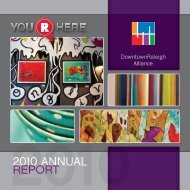Pedestrian Count Study - Downtown Raleigh Alliance
Pedestrian Count Study - Downtown Raleigh Alliance
Pedestrian Count Study - Downtown Raleigh Alliance
You also want an ePaper? Increase the reach of your titles
YUMPU automatically turns print PDFs into web optimized ePapers that Google loves.
Analyzing the trend for each count location separately, it is clear the west<br />
side of Fayetteville Street between Hargett and Martin Streets experiences<br />
the highest peak traffi c, which occurs during the lunch period of 1:01 p.m.<br />
– 1:15 p.m. (See Figure 4-2) with 568 pedestrians counted. All top seven<br />
counts appear in this location.<br />
Top 11-Hour count activity occurs on Fayetteville Street between Hargett<br />
and Martin Streets at the time periods of:<br />
• 1:01 p.m. – 1:15 p.m.: 568 pedestrians<br />
• 12:46 p.m. – 1:00 p.m.: 457 pedestrians<br />
• 1:31 p.m. – 1:45 p.m.: 448 pedestrians<br />
• 12:31 p.m. – 12:45 p.m.: 421 pedestrians<br />
• 1:16 p.m. – 1:30 p.m.: 359 pedestrians<br />
• 12:16 p.m. – 12:30 p.m.: 359 pedestrians<br />
• 12:01 p.m. – 12:15 p.m.: 342 pedestrians<br />
4.1.2 Total Volume Analysis<br />
Total volumes can be analyzed per location as well as per block.<br />
Locations indicate specifi c sides of the street, while blocks add total<br />
volume for both sides to understand the overall volume experienced<br />
between two intersections. Several variables can affect “side of street”<br />
preference. <strong>Pedestrian</strong>s initiate their travel from work, a parking space<br />
or other location in downtown traveling on a specifi c street side. Choice<br />
of path is infl uenced by destination, sun/shade, perceived comfort,<br />
perceived safety, etc. These preferences are outside the scope of<br />
this project, but could be explored in further studies accompanied by<br />
indication of direction, pedestrian surveys, and cognitive mapping.<br />
Total block counts, shown in Table D-1 in Appendix D, illustrate the<br />
volume leader as Fayetteville Street between Hargett and Martin Streets<br />
(see Figure 4-3) experiencing 11,903 pedestrians. The total volume of<br />
pedestrian use over the 11-Hour <strong>Count</strong> period for all blocks was 43,772.<br />
Of this sampling, the least activity was seen on Davie Street between<br />
Fayetteville and Wilmington Streets. Figure 4-4 shows this hierarchy on the<br />
study map.<br />
Higher volumes of use may be attributed to either departure and<br />
destination points and/or convenient links. Although beyond the scope<br />
of this study, future pedestrian surveys can indicate whether use of a<br />
particular block is attributed to high frequencies of block use (departure<br />
and destinations), if the block serves as a key link between two points, or<br />
if the block possesses certain characteristics (i.e., shade, safety, comfort)<br />
that induces path choice.<br />
It is important to note for all total counts: this does not indicate unique<br />
individuals, as it is assumed the same person may be counted walking to<br />
work; to lunch; back to their offi ce after lunch; and back to their home,<br />
vehicle or public transportation source. However, in further studies, this<br />
total volume can be compared year to year to glean an indication of a<br />
change in overall use.<br />
<strong>Pedestrian</strong> <strong>Study</strong> | <strong>Count</strong> Results/Analysis-4.5







